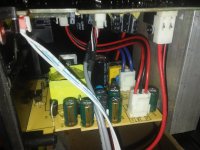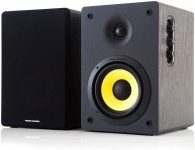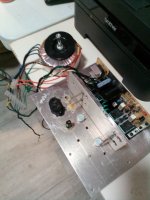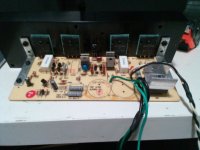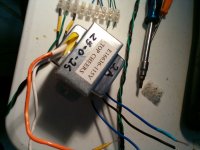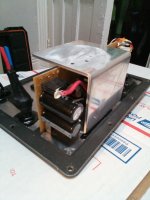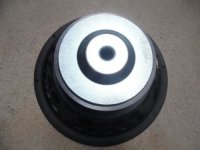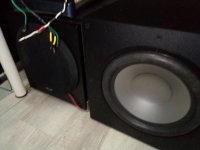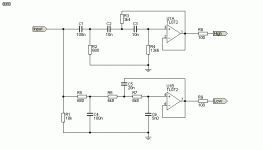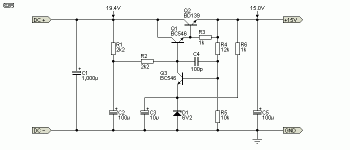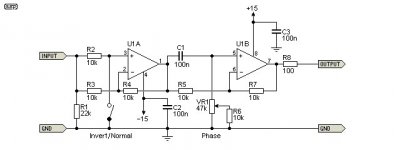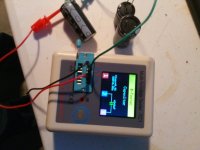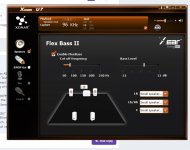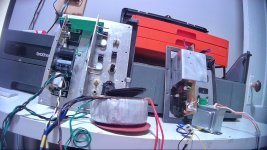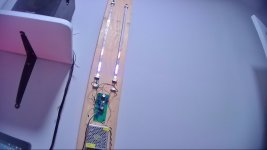Could you share that circuit ?
I am "picky" too.
OS
Well, the replacement sub amp, a 100W model cost only $58 and is a well built reliable unit that I trust - MS 8A 100 Watt Amp
The sleep/standby circuit is featured on the Elliot Sound site (project 38), and I made some mods to make it perfect for getting around the power hungry MS8A main transformer. - Project 38
Because who wants a constant 50 watt AC draw of the sub amp when it's not in use?
The tiny 2 watts in standby/sleep mode are much better on the electric bill when you think about it.
I've added P#38 to my own home built sub as well, with a pair of LEDs showing through behind the speaker grille.
Green when powered on with audio, red when the amp itself goes standby, and both out when sleeping.
The Jun-Fu's would go (Nichicon's) , I'd even replace that EI with a toriod.
If I had to repair a few subs , i'd have a couple spare EI's to build a smaller
DIY amp.
I have noticed on some Toroid based units , they leave the Toriod fully connected. The standby on TDA792x or the slow start pin on the LM3886
brings these chips out of a low power state (plus input mute). Logitech does this.
Some Discrete's (like the polk) sent the OPS into class B , while muting
the input. So my Polk always ran that 50-80VA EI and just input muted and
shifted OPS bias.
Not much of a "standby" - deception even in design.
My Dayton 10" also did this Half-ar$ed design trick - EI was still always
warm , even in standby.
Rant .... Supposedly , since the manufacturer/marketers specify the design parameters to the bottom of the supply chain
(Make it have a standby).... who did this shoddy engineering ?
Polk or Dayton's team ? Or the Asian supplier ?
These companies often even print "designed in the USA" or similar right on
the units. So , this is equal "grifting" between company and supplier.
Logitech at least went halfway , relying on the low core loss of a Toroid and
the built in TDAxxxx's included onboard standby circuitry.
I would almost consider this "true" standby.
OS
If I had to repair a few subs , i'd have a couple spare EI's to build a smaller
DIY amp.
I have noticed on some Toroid based units , they leave the Toriod fully connected. The standby on TDA792x or the slow start pin on the LM3886
brings these chips out of a low power state (plus input mute). Logitech does this.
Some Discrete's (like the polk) sent the OPS into class B , while muting
the input. So my Polk always ran that 50-80VA EI and just input muted and
shifted OPS bias.
Not much of a "standby" - deception even in design.
My Dayton 10" also did this Half-ar$ed design trick - EI was still always
warm , even in standby.
Rant .... Supposedly , since the manufacturer/marketers specify the design parameters to the bottom of the supply chain
(Make it have a standby).... who did this shoddy engineering ?
Polk or Dayton's team ? Or the Asian supplier ?
These companies often even print "designed in the USA" or similar right on
the units. So , this is equal "grifting" between company and supplier.
Logitech at least went halfway , relying on the low core loss of a Toroid and
the built in TDAxxxx's included onboard standby circuitry.
I would almost consider this "true" standby.
OS
Last edited:
No rant on this one....
"Designed in Germany" .... not a lie !! (below 1/2).
Thonet & Vander Kürbis - Not bad , A 3A x 2 SMPS driving an ST TDA7294.
1600uf X2 + 30-0-30VDC , FR-4 and quite ample heatsinks all around.
Not a sub , but a better setup than the POS polk 10".
KMC capacitors = 105C Nippon chemicon ... not bad.
This would be a breeze to repair , uses easily sourced semi's . This
could last 20 years , Loud Vivaldi opera 8 barely made for any heat in this unit.
These units sound as good as my Polk Tsi 200's ... just not as loud.
Here we have strict guidance of the Chinese factory they outsourced to.
I wish more of our OEM's stuck to these business ethics. 🙂🙂
These "wipe the floor" compared with any M-audio or Logitech's.
OS
"Designed in Germany" .... not a lie !! (below 1/2).
Thonet & Vander Kürbis - Not bad , A 3A x 2 SMPS driving an ST TDA7294.
1600uf X2 + 30-0-30VDC , FR-4 and quite ample heatsinks all around.
Not a sub , but a better setup than the POS polk 10".
KMC capacitors = 105C Nippon chemicon ... not bad.
This would be a breeze to repair , uses easily sourced semi's . This
could last 20 years , Loud Vivaldi opera 8 barely made for any heat in this unit.
These units sound as good as my Polk Tsi 200's ... just not as loud.
Here we have strict guidance of the Chinese factory they outsourced to.
I wish more of our OEM's stuck to these business ethics. 🙂🙂
These "wipe the floor" compared with any M-audio or Logitech's.
OS
Attachments
I bought a JLB PSW-D12 in 2000, power supply caps failed two years later. Solved with a Crown DC-300. Some years later found the same model dead sub, amp removed but speaker still in good shape, on ebay and have enjoyed both for a few years on the DC-300. Nice solid base (xover at 85Hz using a dbx Drive Rack PA2. Works great for a small living room, about 400 sqft, and can hear 20 Hz pretty well. 12" Yamaha driver with a 2" vc (would prefer 3", but they perform quite well). I wanted to go with an amp I can trust so my DC-150 got a big brother.
But the DSP - class D OEM plate amps are also POS. I've seen so many
reeeaaly burnt class D's.
[...]The only ones I would care for is a Hypex UcD180 or 400 matched with a
20K - 40K cap bank + Toroid.
The Hypex Fusion plate amps are also solid and sound excellent. I use two FA501s for my two subs.
Much cheaper to just get a plate of aluminum , 100euro's for the UcD400HG.
SMPS 400a400 , 109euro ... perfect.
Looks like standby , protection , +/- 15 Vaux is all in the SMPS.
Interface between SMPS and UcD - cool full amp/PS standby.
All you would need is a 20$ LP filter kit to hook to Vaux.
Wow , did not know Hypex made SM PS's.
OS
SMPS 400a400 , 109euro ... perfect.
Looks like standby , protection , +/- 15 Vaux is all in the SMPS.
Interface between SMPS and UcD - cool full amp/PS standby.
All you would need is a 20$ LP filter kit to hook to Vaux.
Wow , did not know Hypex made SM PS's.
OS
An FA501 does not cost much more than a UcD400 plus a PSU and a plate of aluminium, and it offers better sound quality, integration, and a DSP.
I picked up a Paradign (pair o' dimes) PDR-10 subwoofer with the surround shot. This was repaired without too much expense and I've been using it as part of my PC speakers system, along with a pair of 10"'s in ported boxes for mid/upper bass and a pair of paradigm 110's for mid/high. No doubt the audiophiles will howl but let them.. It's only a PC speakers. A 125W/ch rat chack amp drives it. Amp and computers are all mounted in a small enclosed rack with HEPA filter intake, runs cool and no cat hair.
This sub is hooked up per the paradigm instructions:
Put R and L sub inputs in parallel with R and L speaker wires (yeah the high level across the 8 ohms). Then adjust the sub crossover and volume.
OK worked great for about 8 months and I was satisfied for what it is, but now one of those speaker-level inputs on the sub has lost a bunch of 'gain'. Why? I don't know. Amp popped it?
The high level terminals go in to a bunch of op-amps. The fault stays with that input, so it's the inputs on the cheezy little amp inside the sub. Class D, so doesn't get hot but also all surface mount, not sure if it's worth the time to mess with. Power transformer is very small for the claims. No schematics to be found - usually against my rules for owning something, but the almost free cost was an exception.
The sub also has a RCA type line level input, and the PC has a mono/center/sub output 1/8" jack, so that is next to try and if that works then it'll be OK. I could have done that at first but the cabling from the rack to the desk/speakers/etc. is in a 2" umbilical so somewhat a pita to add more cable inside.
I have no objection to the performance of the box and woofer for what they are used for. If there is a further problem then an external amp might be appropriate
This sub is hooked up per the paradigm instructions:
Put R and L sub inputs in parallel with R and L speaker wires (yeah the high level across the 8 ohms). Then adjust the sub crossover and volume.
OK worked great for about 8 months and I was satisfied for what it is, but now one of those speaker-level inputs on the sub has lost a bunch of 'gain'. Why? I don't know. Amp popped it?
The high level terminals go in to a bunch of op-amps. The fault stays with that input, so it's the inputs on the cheezy little amp inside the sub. Class D, so doesn't get hot but also all surface mount, not sure if it's worth the time to mess with. Power transformer is very small for the claims. No schematics to be found - usually against my rules for owning something, but the almost free cost was an exception.
The sub also has a RCA type line level input, and the PC has a mono/center/sub output 1/8" jack, so that is next to try and if that works then it'll be OK. I could have done that at first but the cabling from the rack to the desk/speakers/etc. is in a 2" umbilical so somewhat a pita to add more cable inside.
I have no objection to the performance of the box and woofer for what they are used for. If there is a further problem then an external amp might be appropriate
look at the PS 1000 schema ( 2) - It is just tip35/36 driven by a CHIP.
PS 1000 schema ( 2) - It is just tip35/36 driven by a CHIP - 3886🙂
1) what´s your point?Fully class B , I suppose it does not matter with a sub.
You hate CHIPS?
They have been used in Audio since the late 60´s, I am an old school full Analog Engineer who "does everything with Op Amps", starting with uA709 and upgrading to the newfangled uA741 in 1970, go figure.
The Audio you are listening to today has passed through dozens of "chips"
2) and that´s not a weak preamp type "chip" as you imply but a muscular 68W RMS POWER AMP.
3) driving two DISCRETE 125W 100V 25 Ampere power transistors.
4) why blame the Chinese?
LM3876 is an AMERICAN creation.
TIP35/36 are also American creations.
The design is American, factory suggested and appearing on Application notes.
Most certain design was submitted by American corporation Polk (or Klipsch, same thing) to various Chinese OEM suppliers, fishing for best price. then THEY chose one.
The American corporation received samples, tested and approved them, then ordered and paid for a production run.
You tell me which is the guiding hand and fully responsible here.
5) where do you see a Class B design?
I see a current boosted Class AB amp (LM3876), a very different thing.
Class B amps have huge distortion at low power because output voltage has to jump two diode drops, a massive 1.4Vpp jump, chopping the lower area of any output signal.
NFB can reduce that, but never eliminate it.
None of that happens here, because within that band output voltage/current is supplied by LM3876 itself, with vanishingly low distortion ; and above a certain level TIP35/36 emitter followers smoothly add current as needed.
No voltage jumps whatsoever, no Class B, considering the whole as a system. (which it is).
6) if anything, it was a flawed and shortsighted (in my view) American decision to "get goods at Chinese salary cost and sell them at US price" , with a very high profit margin, which in the long run became a shoot in their own foot.
Most (all?) initial Chinese factories were installed and paid for with American capital in low cost "special Economic zones" (later other "advanced" countries enthusiastically joined the game), they used American/Japanese/German Technology transferred to them but MOST important, they were given free access to Western markets ... which they smashed through like a Tsunami.
But it was American pressure which forced WTO to accept them as full members, with no restrictions whatsoever.
Will not get into the political background which is outside of DIYA scope, but keep it into the Economic/Cost/Sourcing/Marketing area which is what this very post is talking about.
OK , here is what I got (35$) ... almost glad for the OEM BS that they get 329$ for.
I'm running it with my original 10" project amp... NICE deep 24hz bass. What a magnet (pix 2) !!
It deserves a REAL amp , not this one ... pictures 3/4 .
What a little 25-0-25V trafo and small chip amp !! I rocked that woofer with the full output of my new amp - no issue!
I recapped the second harbinger amp with Rubycon's and stuffed it full of Panasonic D2029-B1347 outputs. I like Japan ! (photo 5/6)
I DO NOT like what is offered for a sub filter. I will design a better filter/phase with op-amps and BJT's.
Free is nice , Trafo and transistors are from a KLH amp 40-0-40 6A and 18-0-18 1A secondary's. I'll use the old polk trafo for my headphone amp.
I'm running it with my original 10" project amp... NICE deep 24hz bass. What a magnet (pix 2) !!
It deserves a REAL amp , not this one ... pictures 3/4 .
What a little 25-0-25V trafo and small chip amp !! I rocked that woofer with the full output of my new amp - no issue!
I recapped the second harbinger amp with Rubycon's and stuffed it full of Panasonic D2029-B1347 outputs. I like Japan ! (photo 5/6)
I DO NOT like what is offered for a sub filter. I will design a better filter/phase with op-amps and BJT's.
Free is nice , Trafo and transistors are from a KLH amp 40-0-40 6A and 18-0-18 1A secondary's. I'll use the old polk trafo for my headphone amp.
Attachments
Now .... for the "rant". While stealing the larger parts of the 12" Polk amp , I noticed the "Ketuo" 50V-4700uF caps. About 1/4 the size of my
new Rubycon's (below 1). how can this be ? My fancy new arduino based tester says 4300uf+ and .36R ESR.
If I did buy this sub for 329$ , I would be pissed indeed. The little Rubicon 2200uf/35V's are almost the size of the Ketuo caps.
Hooking up the filter/phase , I will use a 18db/oct bessel (below 2-4) with ESP's project 123 +phase inverter and powered by a feedback zener referenced
series regulator.
NO simulators on this one ... I will build this for real (as i go along).
new Rubycon's (below 1). how can this be ? My fancy new arduino based tester says 4300uf+ and .36R ESR.
If I did buy this sub for 329$ , I would be pissed indeed. The little Rubicon 2200uf/35V's are almost the size of the Ketuo caps.
Hooking up the filter/phase , I will use a 18db/oct bessel (below 2-4) with ESP's project 123 +phase inverter and powered by a feedback zener referenced
series regulator.
NO simulators on this one ... I will build this for real (as i go along).
Attachments
Last edited:
Nice to see you here again on the forum!! We missed you!Very happy , still alive (with lots of test equipment). Still building stuff . Thimios ??
Thanks to you and the Wolverine team, I built a wonderful amp!!
Gaetano.
Here what i last built.https://www.diyaudio.com/community/...son-of-badger-suggestions.369758/post-6956470Very happy , still alive (with lots of test equipment). Still building stuff . Thimios ??
Ohh , nice stuff. This sub amp is yet another simpler "badger" type amp.
BTW , I was listening to this sub with the new amp ... I noticed there was NO class AB bias. The Panasonic 2SD2029/2SA1347's only have 460mV Vbe.
The original Toshiba's were >500mV+. The amp's fixed Vbe ratio was set for the Toshiba trannies.
For a sub , you can't hear Xover distortion. To be "anal" (perfectionist) , I will at least pull 20ma though the emitter resistors for true AB operation.
NO trimmer on this amp , I'll just parallel something like a 2-5K on the lower leg of the Vbe divider.
I built the ESP regulator. Very nice for a time before IC regulators , under 1mV ripple (-65db+) . Close to a 78L12 (in performance) , would be good
if you had to regulate off of the main supply. BUT - 15 components versus 3 for the 78L12/79L12 pair. Since I do have a low voltage secondary , I will use
the bloody chips (oh , NO !!). I mean , I'm using a TL084 for the filter and phase (yet another evil chip !!).
I am having better luck with evil chips these days LM3886 for 80Hz up , and "gobs" of AB power for my subs. Phase is the trick , that's why this project
has the Bessel filter and ESP's variable phase. Very accurate between 20-100hz. Elliot was using these circuit for active Xovers @ 300 hz and up , less accurate
at the higher frequencies. Most sub amps just have a stupid 0 or 180 phase switch , I'll have the input buffer -->Bessel LPF ---> and the phase circuit.
LPF will just have a switch for 70 or 120hz 18db/oct rolloff. Don't really need a full variable since I have this (DSP Xover on my U7 asus).
But , If I did not have that .... I'd still be good.
BTW , I was listening to this sub with the new amp ... I noticed there was NO class AB bias. The Panasonic 2SD2029/2SA1347's only have 460mV Vbe.
The original Toshiba's were >500mV+. The amp's fixed Vbe ratio was set for the Toshiba trannies.
For a sub , you can't hear Xover distortion. To be "anal" (perfectionist) , I will at least pull 20ma though the emitter resistors for true AB operation.
NO trimmer on this amp , I'll just parallel something like a 2-5K on the lower leg of the Vbe divider.
I built the ESP regulator. Very nice for a time before IC regulators , under 1mV ripple (-65db+) . Close to a 78L12 (in performance) , would be good
if you had to regulate off of the main supply. BUT - 15 components versus 3 for the 78L12/79L12 pair. Since I do have a low voltage secondary , I will use
the bloody chips (oh , NO !!). I mean , I'm using a TL084 for the filter and phase (yet another evil chip !!).
I am having better luck with evil chips these days LM3886 for 80Hz up , and "gobs" of AB power for my subs. Phase is the trick , that's why this project
has the Bessel filter and ESP's variable phase. Very accurate between 20-100hz. Elliot was using these circuit for active Xovers @ 300 hz and up , less accurate
at the higher frequencies. Most sub amps just have a stupid 0 or 180 phase switch , I'll have the input buffer -->Bessel LPF ---> and the phase circuit.
LPF will just have a switch for 70 or 120hz 18db/oct rolloff. Don't really need a full variable since I have this (DSP Xover on my U7 asus).
But , If I did not have that .... I'd still be good.
Attachments
My first sub was a 12” Energy XLS with a nicely finished box and attractive black lacquer top. It had a persistent mechanical hum that I just had to investigate. The power transformer was woefully undersized for what was supposed to be a 450w “peak” amp. Worse, it obviously had too low inductance on the primary side because it ran unloaded with about 50w of power from the line. It was almost too hot to touch. I took the transformer to the dealer who sent it to the nearest repair facility. They sent it back saying that was normal. The power amp was a simple design with 2 to220 mosfets as output stage and about +-55v. Woofer was 8 ohms. So maybe 150W peak. This is what convinced me to build my own subs powered by DIY eq and crossover and separate amps which have included over the years a Hafler DH220, Rotel RB990- (not sure of the model number on that one but 200/330w 8,4 ohms and eventually a Crown CDI1000.
However, even though it had dubious specs and was built no better than it had to be, the Energy sub driver, amp and crossover are still running today without ever having broken or even had a bad connection since 1998. In 2018 I installed the guts into a custom made built in enclosure that provides lows for our kitchen/family room built in system. So, the engineering was done to a price point but the execution resulted in a product that has performed reliably for as long as one would hope for. I do have it on a power bar so it doesn’t sit there burning up watts in the transformer when it’s not operating. I always meant to replace that transformer but never got round to it.
However, even though it had dubious specs and was built no better than it had to be, the Energy sub driver, amp and crossover are still running today without ever having broken or even had a bad connection since 1998. In 2018 I installed the guts into a custom made built in enclosure that provides lows for our kitchen/family room built in system. So, the engineering was done to a price point but the execution resulted in a product that has performed reliably for as long as one would hope for. I do have it on a power bar so it doesn’t sit there burning up watts in the transformer when it’s not operating. I always meant to replace that transformer but never got round to it.
Did it have a hefty toriod ? I saw the XLS amp (Google) , better than both of these OEM Polk's. Here is a picture to show just how pathetic the Polk's are.
At least compared to my upgrade ... he he. The Polk is on the right. I still cant believe the OEM woofer-amp mismatch here , Woofer has a 7cm VC @ 6 ohms and a 25mm+ Xmax. Has to be a 200W+ driver. Magnet is 4Kg or more.
I might add my Arduino VU meter to it (below 2) , trafo has a 6V 3rd secondary , as well.
As far as burning power , a newer toroid will only use 5% of full power wattage at idle. My smaller polk has a 100VA - uses 12w at idle , this on should be <20w for a 250VA . Larger toroids are even more efficient at idle.
What WILL burn the power is if you have the class AB amp at a high bias. I intend on just biasing 10-15mA per device. One could switch out the Vbe to class B
with a external trigger .... back to AB for operation. The LM3886 has the mute pin for this.
I had a Logitech , they left the 100VA toriod always on , muted and idled all the bridged chipamp's. BTW,the 10-12" logitech's are WAY better than Polk or KLH.
KLH is junk , the woofers have tiny magnets .. amps are crap. They want >400$ for that junk. At least Polk uses a real woofer. It was very hard to google a replacement woofer for this XT12 sub , none have blown so it was rare for someone to need a replacement. KLH 10/12's , lots of them replaced ,an easy search.
Energy seems to have an "ample" driver. Kind of a closer match for their amps.
At least compared to my upgrade ... he he. The Polk is on the right. I still cant believe the OEM woofer-amp mismatch here , Woofer has a 7cm VC @ 6 ohms and a 25mm+ Xmax. Has to be a 200W+ driver. Magnet is 4Kg or more.
I might add my Arduino VU meter to it (below 2) , trafo has a 6V 3rd secondary , as well.
As far as burning power , a newer toroid will only use 5% of full power wattage at idle. My smaller polk has a 100VA - uses 12w at idle , this on should be <20w for a 250VA . Larger toroids are even more efficient at idle.
What WILL burn the power is if you have the class AB amp at a high bias. I intend on just biasing 10-15mA per device. One could switch out the Vbe to class B
with a external trigger .... back to AB for operation. The LM3886 has the mute pin for this.
I had a Logitech , they left the 100VA toriod always on , muted and idled all the bridged chipamp's. BTW,the 10-12" logitech's are WAY better than Polk or KLH.
KLH is junk , the woofers have tiny magnets .. amps are crap. They want >400$ for that junk. At least Polk uses a real woofer. It was very hard to google a replacement woofer for this XT12 sub , none have blown so it was rare for someone to need a replacement. KLH 10/12's , lots of them replaced ,an easy search.
Energy seems to have an "ample" driver. Kind of a closer match for their amps.
Attachments
- Home
- Amplifiers
- Solid State
- The tale of two subs - solid state Consumer puffery (rant and solution).
